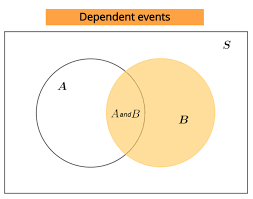
4) Dependent Trials and Tree Diagrams

Dependent Events and Tree Diagrams
[size=150]When the outcome of one event affects the outcome of another event, the events are determined to be dependent events. Events that are not independent are classified as dependent events. [br][br]To determine and classify events as independent or dependent, use the relationships P(A|B) = P(A) or P(B|A) = P(B). [br]Find the Probability of A, P(A), and P(A|B) or the probability of B, P(B), and P(B|A). If the P(A|B) does not equal P(A) or P(B|A) does not equal P(B), the events are dependent. [br][br]The probability that two events A and B will happen in sequence uses the Multiplication rule:[br]P(AnB) = P(A)*P(B|A). [br][br]If the element or item is replaced after the first selection the events are independent. If the element or item is not replaced after the first selection the events are dependent.[br][br]Tree Diagrams are a visual tool used to find the probability of an outcome by multiplying the probabilities of the branches.[br][br]Independent Event: Coin toss tree diagram the outcome of each coin toss is independent of the result of the previous toss. [br][br]Dependent Event: Coin toss tree diagram the outcome depends on the event that happened before it.[br][br]Questions students should be able to answer:[br][br]1) How to determine if two events are independent or dependent?[br][br]2) How does replacement and without replacement affect the outcome of a probability of two events?[br][br]3) How to create a Tree Diagram?[br][br]4) The probability of each iteration of branches has to equal what number? [/size]